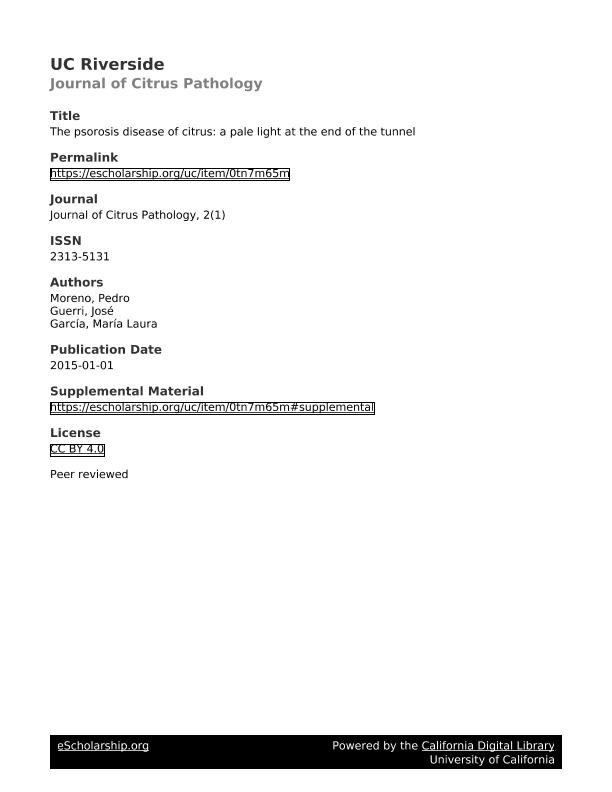Artículo
The psorosis disease of citrus: a pale light at the end of the tunnel
Fecha de publicación:
12/2015
Editorial:
IOCV
Revista:
Journal of Citrus Pathology
ISSN:
2313-5131
Idioma:
Inglés
Tipo de recurso:
Artículo publicado
Clasificación temática:
Resumen
First reported in 1896, psorosis was the first citrus disease proven to be graft transmissible and also the first for which eradication and budwood certification programs were launched to prevent its economic damage. For many years psorosis etiology remained elusive, and only in 1986 was the disease associated with the presence of virus-like particles in infected plants. However, in the last 2 decades a virus with unusual morphology (Citrus psorosis virus, CPsV) was characterized and closely associated with psorosis disease as previously defined by field symptoms and by biological indexing in sensitive indicator plants. With a tripartite, negative-sense, RNA genome and a ~48 kDa coat protein, CPsV, the presumed causal agent of psorosis, is the type member of the genus Ophiovirus, within the new family Ophioviridae. Availability of the complete genomic sequence of 2 CPsV isolates and partial sequences of many others has enabled i) setting up rapid and sensitive RNA-based detection methods, ii) testing different citrus and relatives for resistance to CPsV, iii) identification of the 2 components (psorosis A and psorosis B) traditionally associated with non-scaled and scaled bark inoculum, respectively, from psorosis-infected plants and study their interactions, iv) analysis of genetic variation and evolutionary forces shaping the CPsV populations, v) preliminary studies on the interactions between virus and host factors, and vi) development of transgenic citrus plants expressing variable degrees of resistance to CPsV. In summary, 120 years after the first report on psorosis we start seeing a pale light at the end of the tunnel.
Archivos asociados
Licencia
Identificadores
Colecciones
Articulos(IBBM)
Articulos de INST.DE BIOTECNOLOGIA Y BIOLOGIA MOLECULAR
Articulos de INST.DE BIOTECNOLOGIA Y BIOLOGIA MOLECULAR
Citación
Moreno, Pedro; Guerri, Jose; Garcia, Maria Laura; The psorosis disease of citrus: a pale light at the end of the tunnel; IOCV; Journal of Citrus Pathology; 2; 1; 12-2015; 1-18
Compartir




